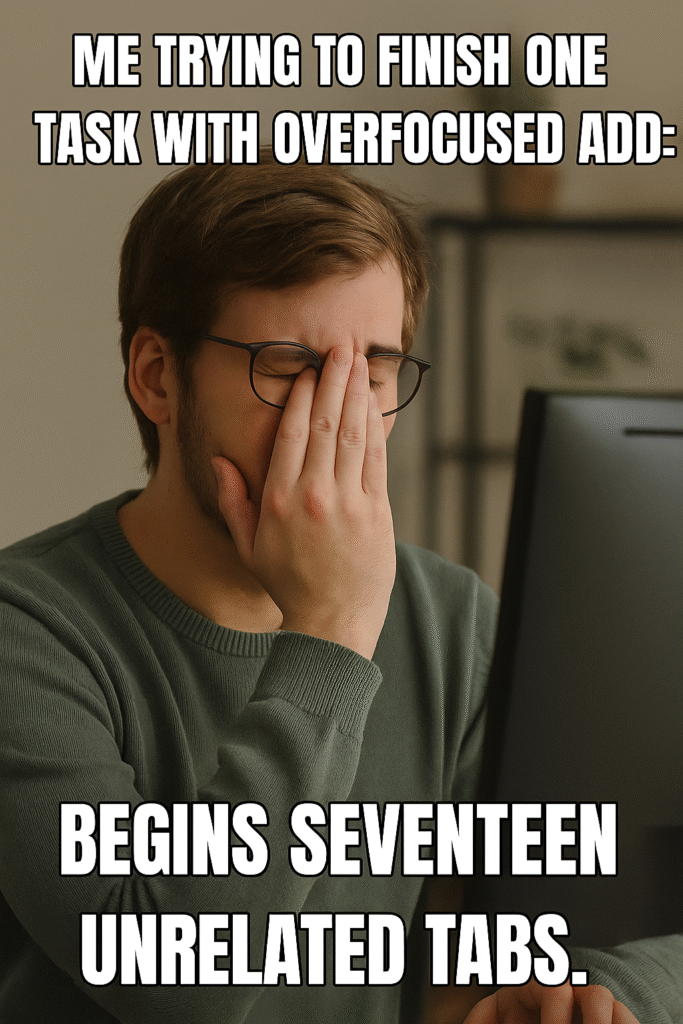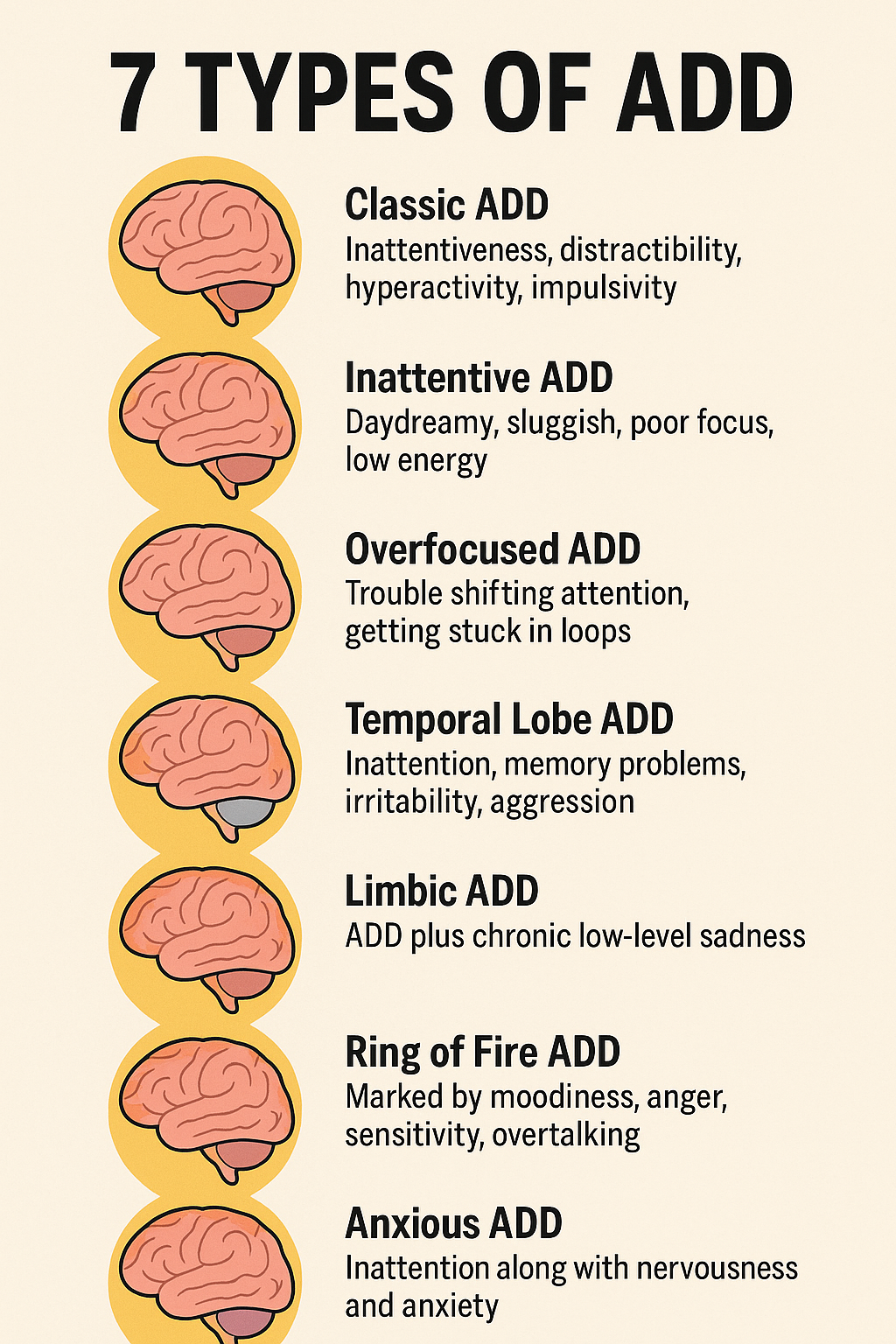You know that moment when you’re minding your business, scrolling through the internet, and then a post pops up that makes you freeze mid-scroll, mid-toast, and possibly mid-existential crisis? That was me this week.
Turns out, there’s not just one type of ADD. Not even two. There are seven. Yes, seven types of attention deficit behaviour, all wreaking havoc in their own uniquely mischievous ways.
And before you ask – no, I haven’t gone rogue or fallen into a Pinterest rabbit hole of wellness woo. This comes from Dr Daniel Amen, a psychiatrist known for his brain imaging work and unorthodox take on mental health. He’s a bit of a marmite figure in medical circles (some love his ideas, others call him a glorified tech salesman), but one thing’s for sure: his seven ADD types have made a lot of people, myself included, feel seen.
Who on Earth is Dr Amen, and Why Should We Care?
Dr Daniel Amen is an American psychiatrist who pioneered the use of brain scans (SPECT imaging) to study behaviour, emotions, and mental health conditions. Instead of just relying on questionnaires and guesswork, he looked directly at the brain’s activity patterns. Cue controversy. The wider psychiatric world tends to raise an eyebrow at SPECT scans, citing insufficient clinical evidence and concerns over overdiagnosis.
But here’s the thing: Amen’s work may not be NHS-standard, but it’s incredibly relatable. Especially when you’ve spent decades thinking, “Why don’t I fit into any of the official ADHD boxes?”
So let’s lift the lid on the seven types of ADD he outlines in his book Healing ADD.
The 7 ADD Types You’ve (Probably) Never Heard Of
Classic ADD: The One We All Know (and Over-Relate To)
This is your poster-child ADHD. Distractible. Hyper. Impulsive. Forgetful. Fidgety. Think: the one who blurts out answers in class, starts three projects and finishes none, and always loses their keys while holding them.
They often respond well to stimulant meds. Which is lovely, until you realise that some of us don’t fit this pattern at all.
Inattentive ADD: The Quiet Daydreamer
This one drifts through life in a bit of a fog. Zoned out, under-stimulated, often labelled lazy or unmotivated. You’ll find her (because it’s often a her) staring out the window while someone explains a spreadsheet. Low energy, low presence, but a massive internal world.
Frequently missed in school, especially in girls who aren’t disruptive but quietly underachieve. They’re not hyper. They’re not loud. They’re just… somewhere else.
Overfocused ADD: ADHD Meets Perfectionism
The brain gets stuck. Like a needle on a record. Can’t shift focus, can’t let go, can’t stop replaying That Thing Someone Said in 2004.
People with Overfocused ADD often appear rigid, controlling, or obsessive. They’re the ones who need things just-so. Intriguingly, this type shows up frequently in children raised in unpredictable homes, including those with alcoholic parents. It makes sense: when your environment is chaotic, controlling your inner world becomes a survival skill.
Stimulants often make this worse. You don’t want more intensity; you want something to soften the loops.
Temporal Lobe ADD: Memory on the Blink
This one comes with emotional storms, mood swings, memory lapses, and occasional aggression. It’s been mistaken for everything from bipolar disorder to borderline personality.
The temporal lobes help regulate mood and memory, so when they’re underperforming, people may appear reactive or forgetful. There’s often a history of head injury, learning difficulties, or a family member with explosive tendencies.
Limbic ADD: The Saddest Surprise
This one shocked me the most, and explained behaviours I’d previously misunderstood.
Limbic ADD is like having ADHD and low-grade depression at the same time. It shows up as low energy, poor self-esteem, hopelessness, and chronic guilt. But unlike clinical depression, it doesn’t usually involve suicidal thoughts or deep despair.
Instead, people seem flat, unmotivated, pessimistic. Here’s the revelation: you might never guess they have ADD at all. You just think they’re emotionally shut down or moody. I’ve come across people like this and couldn’t connect the dots. It was always, “Why are they like this?” Now I realise it wasn’t laziness or disinterest, it was Limbic ADD quietly stealing the joy out of things.
Ring of Fire ADD: When Everything’s Too Much
This one is intense. Emotional outbursts, sensory sensitivity, racing thoughts, and overreacting to just about everything. It’s been linked to inflammation and possibly even autoimmune conditions.
Ring of Fire ADD is easily mistaken for bipolar disorder or severe anxiety. These are the kids (and adults) who feel everything too much, all the time. Their brains light up like a Christmas tree across multiple regions.
Guess what? Stimulants don’t help here. They usually make it worse.
Anxious ADD: Worry With a Side of Procrastination
As if being distracted wasn’t bad enough, this type adds a constant undertone of anxiety. Nervousness, tension, phobias, physical symptoms like stomachaches. Think: classic overthinker who starts tasks late because they’re terrified of doing them wrong.
These individuals often have active basal ganglia (linked to anxiety) and underactive prefrontal cortex (linked to focus). So their thoughts are fast and frantic, but their executive function is on a go-slow.
Overfocused & Limbic Types: The Underrated Game-Changers

For me, the spotlight fell hardest on Limbic ADD. It’s the one no one talks about. And it made me rethink the way I view people who seem stuck, pessimistic, or emotionally flat.
Equally fascinating is Overfocused ADD, especially the link with childhood unpredictability. It makes you wonder how many people we’ve misread, as “stubborn” or “difficult”, when really, they were stuck in a survival loop, gripping onto structure because the alternative was chaos.
A Quick Note on Controversy (Because This Is the Internet)
Dr Amen’s work isn’t without criticism. The broader psychiatric world doesn’t generally endorse SPECT imaging for diagnosis, and his methods haven’t become mainstream.
But for many, especially those who don’t fit the Classic ADD mould, this framework has been a breath of fresh air. It’s not about labelling yourself with a funky new diagnosis. It’s about understanding how your brain might be wired, and offering yourself some grace.
What If We’ve Been Framing ADD Wrong All Along?
Imagine what could shift if we recognised these subtypes earlier. If we treated the flat, joyless ones with compassion rather than irritation. If we saw the perfectionist not as controlling but as overfocused. If we gave anxious brains a different toolkit than the hyperactive ones.
And imagine if people finally got help that matched the way they experienced the world, instead of being handed a generic checklist and a prescription that didn’t work.
So, What Now?
This isn’t a substitute for clinical advice, of course. But if any of these types ring a bell, it might be worth reading Healing ADD or having a deeper chat with a professional.
And if nothing else, let it be a reminder that neurodivergence wears many faces. Some are loud, some are flat, some are looped on thought spirals. All are valid.
So, have you ever met someone who seemed like they had ADHD but didn’t fit the mould? Or maybe you’re sitting there realising one of these types is… suspiciously you?
Let’s talk.
*This image is AI-generated with prompts made by me and serves no educational purpose, it is only used to highlight certain aspects of this article.




